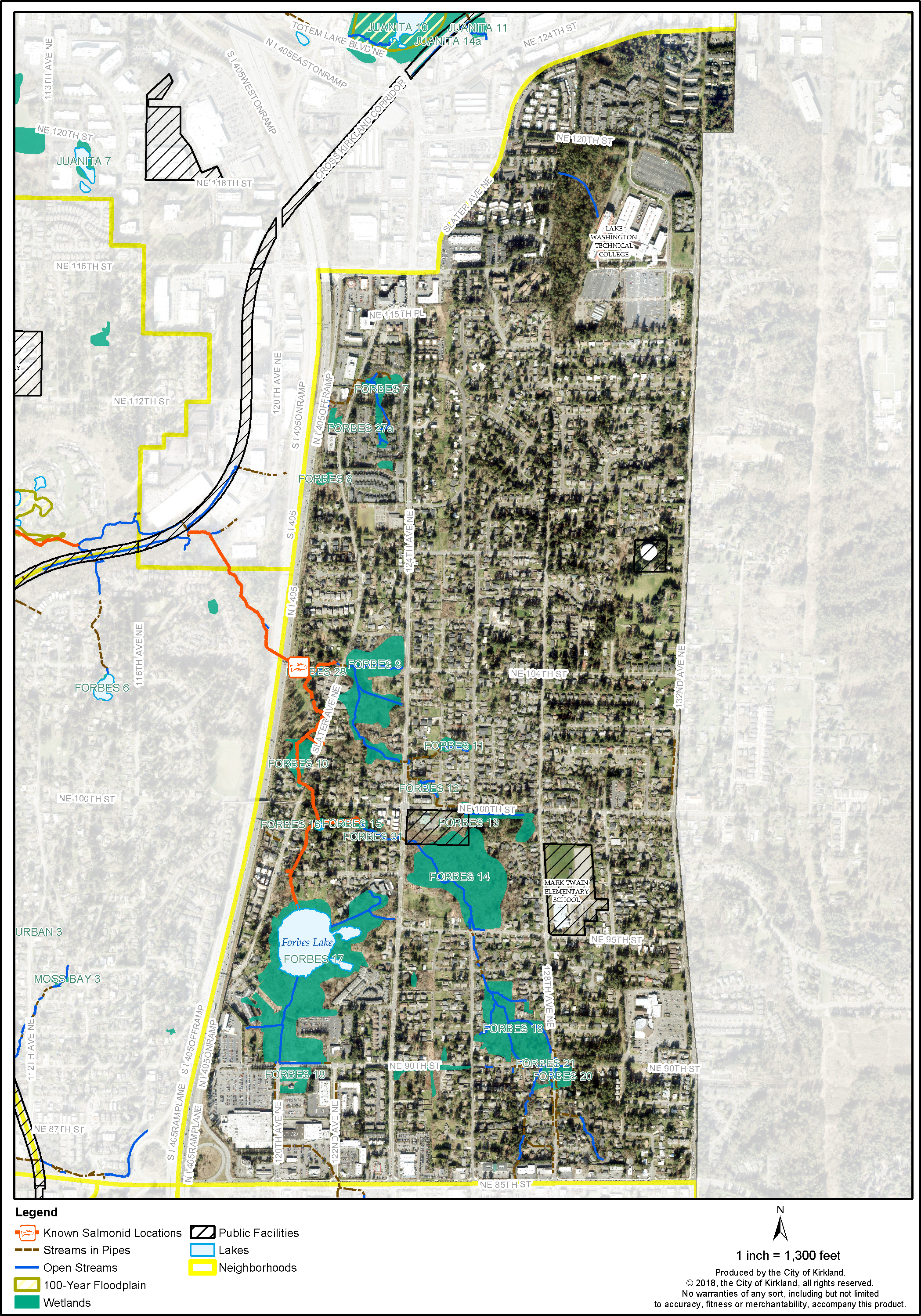5. NATURAL ENVIRONMENT
The Rose Hill Neighborhood contains significant wetland areas, Forbes Lake, and tributaries and the headwaters of Forbes Creek that eventually feed into Lake Washington. Together these critical areas constitute a valuable natural drainage system that is an integral part of managing the City’s surface water by storing and conveying storm and flood water. These natural features also help maintain water quality, recharge groundwater, provide wildlife and fish habitat, and provide open space and aesthetic enjoyment.
Several areas of high and moderate landslide susceptibility and areas prone to liquefaction in a seismic event are located in the neighborhood, which require a geotechnical study with development.
The significant stands of native trees and native vegetation on hillsides, along stream banks and in wetland areas in Rose Hill provide opportunities for wildlife corridors and will help meet the City’s urban forest goal to provide an overall 40% tree canopy coverage.
Environmental policies in Rose Hill strive to protect and enhance natural environmental quality and natural amenity and function, to avoid potential environmental hazards, and to utilize sustainable management practices.
The following maps show critical areas within the Rose Hill Neighborhood. See the Natural Environment Element for more information on wetlands, streams, and associated buffers as well as landslide and seismic hazard areas, trees and wildlife. The Kirkland Zoning Code regulates tree removal and development in critical areas.
Figure RH-5: North Rose Hill Landslide Susceptibility
Figure RH-6: South Rose Hill Landslide Susceptibility
Figure RH-7: North Rose Hill Liquefaction Potential
Figure RH-8: South Rose Hill Liquefaction Potential
Figure RH-9: North Rose Hill Wetlands, Streams, and Lakes
Figure RH-10: South Rose Hill Wetlands, Streams, and Lakes
Policy RH 56:
Investigate water quality and Forbes Lake flooding/levels and develop projects and programs and provide funding to address identified problems.
Lake level fluctuations on property adjoining Forbes Lake contribute to inundation of drain fields and basement flooding. Lake level fluctuations may be caused by both the timing and amount of water entering the lake, or by blockages in the channel downstream of the lake. Ongoing monitoring by community volunteers and by the City quantify lake level fluctuations and test water quality. Current development practices reduce the potential for flooding by restricting placement of new improvements within critical area buffers, requiring that development projects meet certain thresholds to control the quantity and quality of storm water flows, and eliminating septic system failures by requiring connection to the sanitary sewer system. If lake level fluctuations are being caused by inflows to the lake, consider opportunities to reduce flows through storm water detention. Such projects would be prioritized based on identified need in the Surface Water Master Plan. Much of the downstream channel is on private property where property owners are encouraged to seek permits for and implement projects to clear the channel of debris and beaver dams.
Policy RH 57:
Protect notable trees and groves of trees.
While a municipal heritage or notable tree program is not currently in place, the neighborhood supports voluntary efforts to encourage preservation of heritage trees and significant groves. Heritage trees are set apart from other trees by specific criteria such as outstanding age, size, and unique species, being one of a kind or very rare, an association with or contribution to a historical structure or district, or association with a noted person or historical event.
Policy RH 58:
Encourage creation of backyard sanctuaries for wildlife habitat in upland areas.
People living in the neighborhood have opportunities to attract wildlife and improve wildlife habitat on their private property. These areas provide food, water, shelter, and space for wildlife. The City, the State of Washington Department of Fish and Wildlife, and other organizations and agencies experienced in wildlife habitat restoration can provide assistance and help organize volunteer projects.
|
Backyard Sanctuary Program |
|
Learn more about the Backyard Wildlife Sanctuary Program at: https://wdfw.wa.gov/living/backyard/ |








